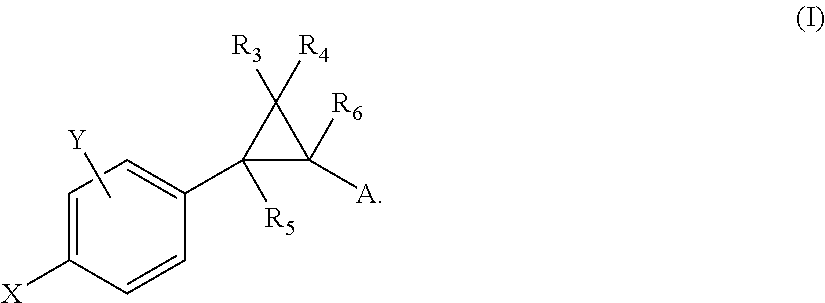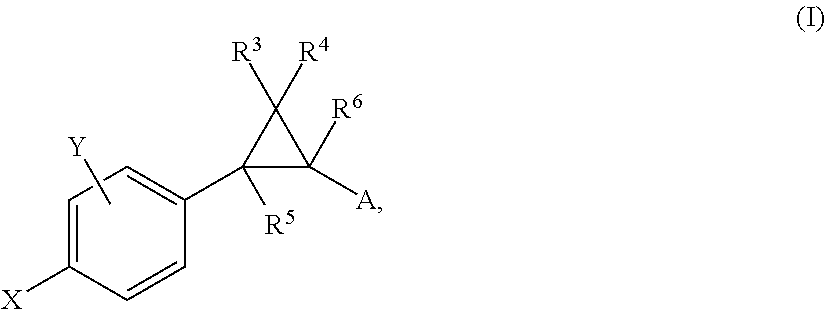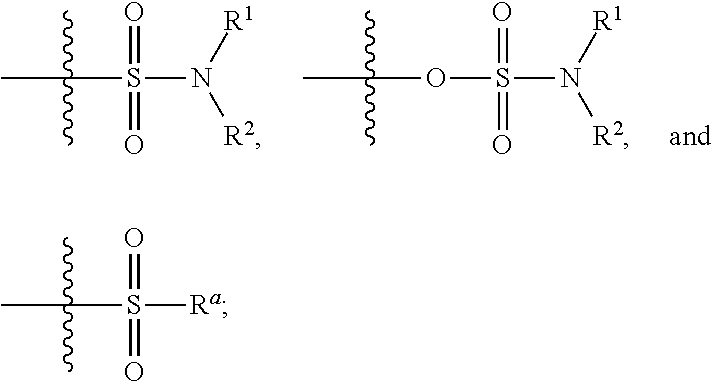Allosteric modulators of nicotinic acetylcholine receptors
a technology of nicotinic acetylcholine and allosteric modulators, which is applied in the direction of heterocyclic compound active ingredients, drug compositions, organic chemistry, etc., can solve problems such as dyskinesia, and achieve the effect of preventing, treating or reducing diseas
- Summary
- Abstract
- Description
- Claims
- Application Information
AI Technical Summary
Benefits of technology
Problems solved by technology
Method used
Image
Examples
example 1
[0584]
4-((1S,3S)-3-(3-(5-Fluoro-2-methylphenyl)-1,2,4-oxadiazol-5-yl)-2,2-dimethylcyclopropyl)-benzenesulfonamide
[0585]To a solution of (1S,3S)-2,2-dimethyl-3-(4-sulfamoylphenyl)cyclopropanecarboxylic acid (Intermediate 5) (150 mg, 0.558 mmol) in 1,4-dioxane (2.8 mL) was added 1,1′-carbonyldiimidazole (101 mg, 0.624 mmol). The reaction mixture was warmed to 45° C. and allowed to stir for 2 h. The reaction mixture was cooled to ambient temperature and 5-fluoro-N′-hydroxy-2-methylbenzimidamide (Intermediate 1) (104 mg, 0.617 mmol) in 1,4-dioxane (1.5 mL) was added. The reaction mixture was warmed to 110° C., allowed to stir for 5 h, then allowed to cool, and was concentrated under reduced pressure. The residue was purified by silica gel chromatography, eluting with a gradient of ethyl acetate:hexanes—0:100 to 40:60 to afford the title compound. MS: m / z=402.2 [M+H]. 1H NMR (500 MHz, CDCl3): δ 7.91 (d, J=7.9 Hz, 2H); 7.73 (d, J=9.6 Hz, 1 H); 7.41 (d, J=8.0 Hz, 2H); 7.07-7.10 (m, 1 H); 4...
example 2
[0586]
4-((1S,3S)-3-(5-(2-Cyclopropylethyl)-1,2,4-oxadiazol-3-yl)-2,2-dimethylcyclopropyl)benzene-sulfonamide
[0587]To a solution of 3-cyclopropylpropanoic acid (59.8 mg, 0.524 mmol) in 1,4-dioxane (2.40 mL) was added 1,1′-carbonyldiimidazole (85 mg, 0.52 mmol). The reaction mixture was warmed to 85° C. and allowed to stir for 20 min. The reaction mixture was cooled to ambient temperature and (1S,3S)-N′-hydroxy-2,2-dimethyl-3-(4-sulfamoylphenyl)cyclopropane-carboximidamide (Intermediate 10) (135 mg, 0.476 mmol) was added. The reaction mixture was warmed to 130° C., allowed to stir for 1 h, and then allowed to cool and was concentrated under reduced pressure. The residue was purified by preparative HPLC, eluting with a gradient of acetonitrile:water:trifluoroacetic acid—10:90:0.1 to 95:5:0.1. The product-containing fractions were concentrated under reduced pressure to remove acetonitrile. The remaining solution was made basic with saturated aqueous sodium bicarbonate (5 mL) and extract...
example 3
[0588]
4-((1S,3S)-2,2-Dimethyl-3-(5-(2,3,6-trifluorophenyl)-1,2,4-oxadiazol-3-yl)cyclopropyl) benzenesulfonamide
[0589]To a solution of 2,3,6-trifluorobenzoic acid (73.2 mg, 0.416 mmol) in 1,4-dioxane (1.80 mL) at ambient temperature was added 1,1′-carbonyldiimidazole (75 mg, 0.46 mmol). The reaction mixture was warmed to 85° C. and allowed to stir for 20 min. The reaction mixture was cooled to ambient temperature and (1S,3S)-N′-hydroxy-2,2-dimethyl-3-(4-sulfamoylphenyl)cyclopropanecarboximidamide (Intermediate 10) (105.1 mg, 0.371 mmol) in 1,4-dioxane (1.5 mL) was added. The reaction mixture was warmed to 130 ° C., allowed to stir for 1.5 h, and then allowed to cool and concentrated under reduced pressure. The residue was purified by preparative HPLC, eluting with a gradient of acetonitrile:water:trifluoroacetic acid—15:85:0.1 to 90:10:0.1. The product-containing fractions were concentrated under reduced pressure. The residue was taken up in methanol (5 mL) and treated with MP-carbon...
PUM
 Login to View More
Login to View More Abstract
Description
Claims
Application Information
 Login to View More
Login to View More - R&D
- Intellectual Property
- Life Sciences
- Materials
- Tech Scout
- Unparalleled Data Quality
- Higher Quality Content
- 60% Fewer Hallucinations
Browse by: Latest US Patents, China's latest patents, Technical Efficacy Thesaurus, Application Domain, Technology Topic, Popular Technical Reports.
© 2025 PatSnap. All rights reserved.Legal|Privacy policy|Modern Slavery Act Transparency Statement|Sitemap|About US| Contact US: help@patsnap.com



